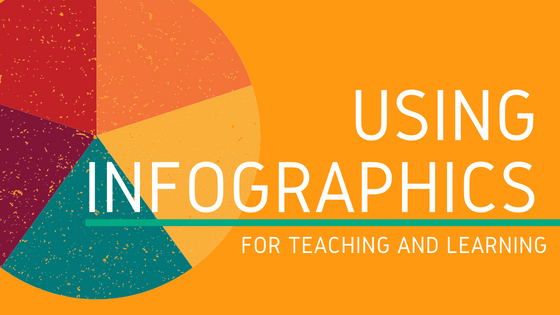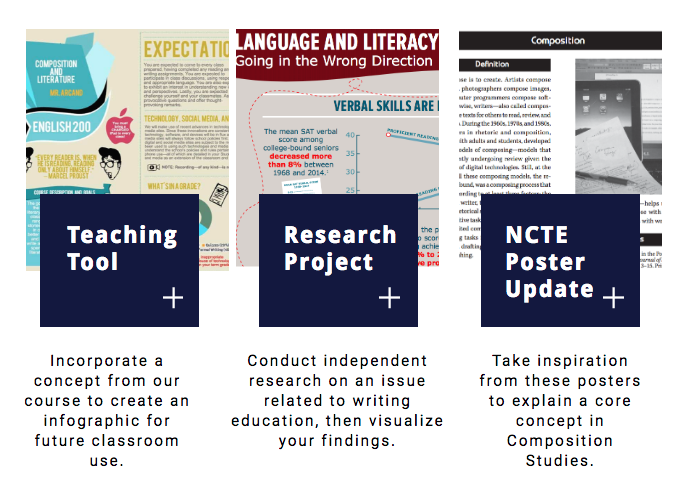
Courtesy of Learning Technologies.
This is the first part in a series by Anna Ioanes (Brittain Fellow, 2015-2018) on teaching infographics and writing at the University of St. Francis where Dr. Ioanes is Assistant Professor of English. The series originally appeared at the USF Lit Works blog.
Introduction
In my first semester at the University of St. Francis, I taught an upper-division course in Teaching Composition, which was designed to prepare future English teachers to teach writing. The students came to the course with diverse goals: some were planning to teach high school English, some to teach middle school English, and some to be writers themselves. Having never taught an advanced composition course before, I was excited, if a bit nervous, to introduce this group to theories of writing and rhetoric. The course was organized around four premises:
-
- Writing makes things happen
- Writing happens in context
- Writing is a process
- Writing is multimodal
Drawing on theories of multimodal composition I encountered as a Brittain Fellow at Georgia Tech, I incorporated a unit on multimodality and designed a multimodal assignment. Students worked in pairs to create a research-based infographic on a topic related to the course. While all of the assignments were designed to draw on multiple modes of communication and address real rhetorical situations (by solving actual problems for actual audiences), this project in particular was designed to enact the theories we were also learning about. Most of the students had never created an infographic, and they really taught themselves how to synthesize complex information and present it to audiences that ranged from other English majors to middle-school writers. I’m proud to share their creations with TECHStyle readers in this four-part series.
Part One: Picturing Research and Planning for Careers
Are great writers born, or made? Scholars who study the writing process and the teaching of writing tell us that writing is a process that can be taught and strengthened, even as they acknowledge that writing–truly beautiful writing–is a mysterious phenomenon that manifests in a feel for language, in the ear, in the voice, through what Sondra Perl calls “felt sense” (365). When we think about what writing is, how we learn it, and how we might teach it, we are met with contradictions. Our English 318 course, “Teaching Composition,” wrestles with these contradictions by engaging with canonical works of rhetorical theory and composition studies and working on assignments that will feed into our students’ careers as teachers and writers. Given the digital context in which we write and learn to write, I wanted to ask students to create multimodal texts–ones that incorporate images, sound, or movement in addition to written text. For their first major research project, students in “Teaching Composition” worked in pairs to create infographics about writing.
In the spirit of the project, I gave students the assignment in the form of an infographic, which you can view here. Students worked in pairs and created their own research topic, which was designed with a specific audience in mind–like other English majors or high school English teachers. I offered possible guidelines, but largely let the groups define their projects. Two groups focused on teaching writing as a process, not a product: one group created their infographic for fellow teachers, and one created their infographic for students. Another group translated one of our theoretical readings, about the role of metaphor in the writing process, into an infographic format, with future undergraduate students in mind for their audience. The fourth group also addressed their peers, creating an infographic that would show undergraduates the many career paths available to English majors. In a series of posts, I will share these infographics along with their creators’ explanation of how–and why–they translated their research into this visual, digital format.

Here is part of our infographic assignment page.
First up, this post features a project created by Eva Bruno and Matt Oyer, who wanted to research career paths for English majors. In addition to its less-tangible benefits–reading and thinking deeply, finding your own voice as a writer–the English major prepares students for a wide variety of careers. As Matt and Eva show in their infographic, even students interested in careers in the sciences can benefit from majoring in English. Here’s how Matt and Eva described their project:
Most people, including those of us in close interaction with the English department, tend to default to teaching or becoming an author as the only paths beyond graduation for an English major. Our partnership in this project was what specifically drove us to create an infographic on the topic of potential careers for English majors because, although one of us is pursuing a teaching certification (Eva), the other (Matt) is not. We wanted students, especially undergrads who have not declared a major, to know that even if they don’t want to teach, there are still options for them if they are interested in the various aspects of English. All too often, people fail to realize the versatility of an English degree, resulting in the skepticism we frequently face (“But what are you going to DO with that degree?!”) when asked about our area of study. Our infographic explores a few lesser known options and will hopefully spark interest in readers to help our department grow.

Infographic created by Eva Bruno and Matt Oyer.
Works Cited
Perl, Sondra. “Understanding Composing.” College Composition and Communication, vol. 31, no. 4, Dec. 1980, pp. 363-369. JSTOR. https://www.jstor.org/stable/356586. Accessed 2 Dec. 2018.

